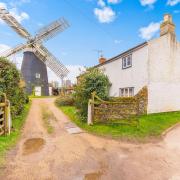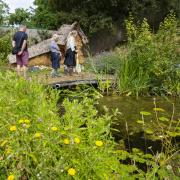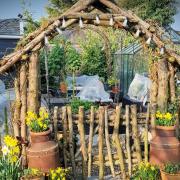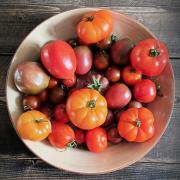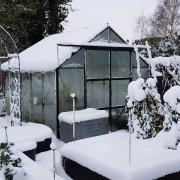In this coronation year, you may have been tempted to buy the ‘King Charles Coronation’ pink floribunda rose launched by Harkness. It’s a fully double extravagance of prize blooms; such roses often mark royal occasions, special anniversaries or birthdays.
The new rose is hard to reconcile with the wild flowers, birds and bees on the King’s Coronation invitation, complete with green man to symbolise spring and rebirth. Remember the furore over whether that neo-pagan symbol would be suitable for a Christian ritual? That's largely died down but, thankfully, roses live on. What we do know is that His Majesty likes to celebrate nature, yet the rose bred in his honour is effectively closed to bees and other pollinators due to the mass of petals blocking access.
But let’s keep it neutral. Roses subjected to artificial selection by plant breeders often aim to produce the largest, most spectacular flowers and deliver the performance of a premiership footballer. Advantages are their many fragrant blooms, healthy foliage, repeat flowering and disease resistance. But nothing is ever straightforward. It's widely reported that well-known rose breeder David Austin recently withdrew some popular roses due to climate change and an increase in pests and diseases. Now the company has reportedly been re-trialling its roses to strive for more climate-adaptable flowers through crossing with more disease resistant plants.

Moving from rich river loam to sandy soil, I soon realised we’re limited in growing healthy roses, but it’s allowed us to appreciate species roses, the wild ones that tend to have natural disease resistance. What’s more, there are some lovely examples, such as the vivid magenta Rosa glauca, with its purple foliage and burgundy hips, and scarlet Rosa moyseii, both of which are perfectly suited to our wild front garden.
Peter Beales of Attleborough, with 50 years' experience and multiple Chelsea gold medals, is renowned for its historic collection of old roses, as well as a fine selection of classic and modern. Ian Limmer, longstanding nursery manager, who worked closely with the late Peter Beales, tells me they have at least 100 varieties of roses that are good for wildlife, 40 of them species roses which are the ancestors of all roses. Here are three of his favourites.

'Rosa nitida is a short growing variety of about a metre in height and has lovely magenta type flowers. For me, not only is it tough it has magnificent purple to coppery foliage, with the added bonus of burgundy hips. Rosa moyesii is a wonderful rose with dusky, blood red single flowers. This rose can easily get to a height of 3 m and is distinguished by the many leaves on each leaflet stem. In autumn the flagon-shaped, bright red hips are very appealing, making this a very ornamental shrub. Rosa pimpinellifolia, growing to about 1.25 m high, has a creamy single flower with ferny foliage. The black hips make this rose really stand out in the autumn. All of these varieties are very tough and will grow in most soil conditions.'
If wildlife is your priority, you need to imagine yourself as a bee. Ask yourself, how easy would it be to access the centre of the rose, where the pollen is? Single roses or loosely petalled semi-doubles make life easier for wild and honey bees as well as other pollinators. Two of my favourites are the China shrub rose ‘Mutabilis’, its single blooms like torn silk, mutating from cream to peach to cerise, and the semi-double climber ‘Maigold’. It’s described by Peter Beales as robust with an abundance of glossy foliage, and I can vouch for that.

There are some real beauties with easy access for bees and other pollinators; many have the benefit of autumn hips for birds in winter. But do you know what? Bees in my garden often prefer flowers such as catmint, echium, and helenium, especially if they can move easily from one source of pollen to another. So as long as you give your roses – whether blousy doubles, semi-doubles, or simply singles – space to breathe and put down healthy roots, they will happily settle in with bee-friendly herbaceous plants.
Gone are the days of roses in dedicated beds, when diseases spread like wildfire and pesticides were sprayed liberally. As for aphids, according to the RHS, their many predators include birds, hoverfly and lacewing larvae, and ladybirds, so let’s not get hung up about them. And if you think roses are hard to maintain, Ian Limmer will tell you that amateur pruning never killed a rose. That said, you need to get your roses off to a flying start. They like clay, enjoy a well-balanced loam, tolerate sandy conditions, but struggle a bit on chalk, in which case you’ll need conditioning with well-rotted manure or (preferably) peat-free compost. Ian has some fantastic tips on planting and caring for roses on the Peter Beales website.

Few flowers attract such strong feelings as the rose, which isn’t surprising as it has been regarded as the national flower of England since the 15th century Wars of the Roses. The heraldic Tudor rose, featured on the King’s invitation, is a combination of red rose for House of Lancaster and white rose for House of York, unified by the marriage of Henry VII to Elizabeth of York, thus founding the Tudor dynasty. Even so, my Yorkshire brother-in-law never fails to remind me who’s who when the subject of roses comes up. He will be heartened by Ian Limmer’s other choice of an exquisite, semi-double, bee-accessible white climber called ‘City of York’, which Ian describes as 'One of my favourite roses for insects bees and butterflies and a wonderful fragrance with lovely glossy foliage'.
There you are, peace reigns. No, not that ‘Peace’. That’s the famous hybrid tea. See? Nothing is straightforward when it comes to roses. But I must add a footnote (whisper it) that our ‘Suffolk’ county rose is actually red, a real beauty and, although bees apparently can’t distinguish the colour red very well, they will home in on its golden, pollen-laden anthers.
Peter Beales Roses classicroses.co.uk
READ MORE: Why roses are the flower of the summer English garden

The historic hybrid musk
An historic collection of hybrid musk roses, part of an important Plant Heritage National Collection, is held by Debbie Symes who runs a livery stable at Bramfield, near Halesworth. Debbie has at least 27 cultivars bred by Pemberton and Bentall (1912-1939).
Essex clergyman the Rev Joseph Pemberton set about breeding roses after exhibiting a selection of his grandmother’s favourites at the National Rose Society Show in 1882. Visitors liked what they saw and Rev Pemberton, together with his sister, Florence, and later his gardener, John Bentall, raised 69 Hybrid Musk roses.
'I have a particular love of single and semi double roses, and have grown the Pemberton/Bentall Hybrid Musk roses for many years,' says Debbie. 'They're particularly easy roses, needing little pruning, and with exceptional disease resistance. Fabulous panicles of blooms with a sweet musky perfume. Every garden should have at least one!'
Hybrid musks are richly scented, strong growers, and flower from mid-May into autumn. Debbie has chosen two to share with readers, both repeat flowering and raised in the 1920s by the Rev Pemberton.
The shrub rose ‘Vanity’, grows to 1.8 metres tall and bears sprays of large, single, deep pink flowers, while 'Cornelia' is a vigorous, medium-sized shrub with dark bronze-tinted foliage and sprays of very fragrant flowers, opening coppery-apricot and becoming pink-flushed with age.
After Pemberton died, John Bentall carried on breeding roses, among them the well-known single rose ‘Ballerina’ in 1937 and ‘Buff Beauty’ in 1939.
Opening times to view the collection are by arrangement. Find out more at plantheritage.org.uk/local-groups/suffolk
READ MORE: How to spot problems with your roses and how to fix them











